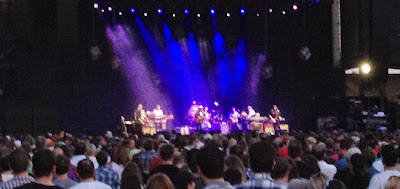The Grant Park Symphony Orchestra is a publicly sponsored symphony orchestra that provides free performances as part of the Grant Park Music Festival during the summer months in Millennium Park in Chicago. The Grant Park Chorus, a related organization, often appears with the Orchestra as well as performs on its own. Concerts are held mostly on weekday evenings at Jay Pritzker Pavilion, a bandshell in Millennium Park in the Loop that can host up to 11,000 attendees. The space consists of a seated area close to the stage and a large, sprawling lawn where most attendees sit and lounge. Seats close to the stage are still free, but it’s generally understood that those are reserved for those who are truly interested in the music, while the grass is for those who are more interested in their picnics and conversations. Sitting towards the back of the lawn, we were amongst people that were definitely in that latter category, as was I. It was a beautiful evening and a beautiful space, better than any happy hour venue in the city. Tonight’s performance would consist of two parts, Beethoven’s Piano Concerto No. 1 and Shostakovich’s Symphony No. 5.

Everyone knows, German Classical and Romantic composer and pianist Ludwig van Beethoven, amongst the most famous and influential musicians of all time. His Piano Concerto No. 1 in C major, op. 15 is well known and regarded in the classical music community, even if not as iconic as some of his other works. It included three movements, with a combined running time of a little over half an hour. The piece was quiet and somewhat hard to hear over the conversations all around me, but certainly added ambience to the overall aesthetic of the space. It was a mixture of delicate high notes and grand bass. Even though it was a piano concerto, and the piano was often the most prominent instrument, there was still a lot else going on in each of the sections. Many sections prominently feature sweeping strings and brass.
Russian-born Dmitri Dmitriyevich Shostakovich, while not as universally known as Beethoven, is nonetheless a prominent figure in 20th century orchestral music. I found the back story behind the composition of his fifth symphony quite interesting. Shostakovich wrote the piece after many of his previous pieces were criticized for not conforming to Soviet standards and properly representing the ideals of socialism. It’s kind of hard to think what that may mean, considering its non-vocal symphonic music, so any interpretation of complex messages in the music is for the listener to decide. Nonetheless, after he had been threatened and many of his friends and relatives disappeared to the Gulag, he was under immense pressure to release a satisfactory work. He had to deliver the simple heroic classicism demanded by the authorities, but mock it just subtly enough to stay true to his personal belief without them catching on. Upon release, the piece proved a great success and earned him a spot back in the good graces of Stalin and other Soviet party leaders. However, he said of the work in his memoirs, “I think it is clear to everyone what happens in the [finale of the] Fifth Symphony. The rejoicing is forced, created under threat. It’s as if someone were beating you with a stick and saying, ‘Your business is rejoicing, your business is rejoicing,’ and you rise, shaky, and go marching off muttering, ‘Our business is rejoicing, our business is rejoicing.’ What kind of apotheosis is that? You have to be a complete oaf not to hear that.” I’m not sure I heard his interpretation of this rejoicing business, so I guess he would presume me an oaf. Or maybe this is the story he just liked to tell himself to maintain his dignity, at least in his own mind.
His Symphony No. 5 in D minor, Op. 47, was first performed on November 21, 1937 in Leningrad. It consists of 4 movements, which combined, last about 45 minutes. The first movement is one of those pieces that I felt like I’ve heard before but couldn’t quite put my finger on where I’ve heard it. It sounded like it could have easily been featured in as part of a thrilling 1930’s noir film, where the hardboiled detective saves the girl and defeats the killer. The second movement was much more pomp, while things slowed down considerably in the third. The fourth marches up the tempo again. At times, the piece was booming and hard to ignore, though most of the people around me were doing a pretty good job. It ends on a particularly grand note with booming drums. The whole evening made me want to pay more attention to some of the great classical music as well as take advantage of any excuse to be outside on a beautiful summer night.












